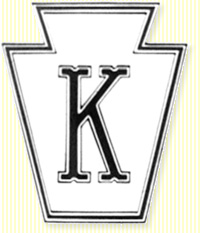
 Keystone Film Company
While both the keystone and the triangle are significant images in masonic iconography, there is no reason to conclude that the names were chosen for their masonic significance. Of the many men involved in these film companies, only D. W. Griffith has been identified as a freemason.
On April 14 1909 the New York Motion Picture Co. was founded by Adam Kessel Jr. and Charles Baumann, who had previously run the Empire Film Exchange, together with cameraman Fred Balshofer. Apparently, when the three men met over dinner to set up their new business, they had not yet decided on a name or trademark for their production arm. Then Kessel spotted an American buffalo on the $10 bill, and Bison Films was born.
On June 8, 1912, Universal Film Manufacturing Company was founded, the result of a merger of IMP (Carl Laemmle), Powers Motion Picture Co. (Pat Powers), Rex Motion Picture Company (William Swanson), Champion Film Company (Mark Dintenfass), Nestor Film Co. (David Horsley), and the New York Motion Picture Co. (Charles Baumann and Adam Kessel).
The Keystone Film Company, later Triangle-Keystone, was founded by Mack Sennett—born Mikall Sinnottco (1880/01/17-1960/11/05)—in Edendale, California in 1912 as the Keystone Pictures Studio with Adam Kessel Jr. and Charles O. Baumann. In 1915 Kessel and Baumann were billed as the managers; in 1916 they were billed as executives. Kessel and Bauman were experienced independent producers and owners of the New York Motion Picture Company which merged with the Universal Film Manufacturing Company in 1912. The company filmed in and around Glendale and Silver Lake for several years. The New York Motion Picture Co. controlled Bison Life Motion Pictures
Adam Kessel Jr. and Charles Baumann, operators of the New York Motion Picture Company, were associated with both the Triangle Film Corporation and the Willat Studios, Inc., a laboratory and studio facility which "Doc" Willat opened at the corner of Main Street and Linwood Avenue in 1914.
Harry E. Aitken accumulated a personal fortune from The Birth of a Nation. He then organized the Triangle Pictures Corporation. Triangle was envisioned as a prestige studio based on the producing abilities of ace filmmakers D. W. Griffith, Thomas Ince, and Mack Sennett. Aitken offered smaller partnerships in Triangle to Adam Kessel and Charles Baumann, producers of the Kay Bee films.
Image from He Did and He Didn't (Triangle-Keystone, US 1916)
Directed by Roscoe Arbuckle; ph: Elgin Lessley; cast: Roscoe "Fatty" Arbuckle, Mabel Normand, William Jefferson, Al St. John, Joe Bordeau. rel. 30.1.1916. 35mm, 2 rls., Library of Congress.
Keystone Film Company
While both the keystone and the triangle are significant images in masonic iconography, there is no reason to conclude that the names were chosen for their masonic significance. Of the many men involved in these film companies, only D. W. Griffith has been identified as a freemason.
On April 14 1909 the New York Motion Picture Co. was founded by Adam Kessel Jr. and Charles Baumann, who had previously run the Empire Film Exchange, together with cameraman Fred Balshofer. Apparently, when the three men met over dinner to set up their new business, they had not yet decided on a name or trademark for their production arm. Then Kessel spotted an American buffalo on the $10 bill, and Bison Films was born.
On June 8, 1912, Universal Film Manufacturing Company was founded, the result of a merger of IMP (Carl Laemmle), Powers Motion Picture Co. (Pat Powers), Rex Motion Picture Company (William Swanson), Champion Film Company (Mark Dintenfass), Nestor Film Co. (David Horsley), and the New York Motion Picture Co. (Charles Baumann and Adam Kessel).
The Keystone Film Company, later Triangle-Keystone, was founded by Mack Sennett—born Mikall Sinnottco (1880/01/17-1960/11/05)—in Edendale, California in 1912 as the Keystone Pictures Studio with Adam Kessel Jr. and Charles O. Baumann. In 1915 Kessel and Baumann were billed as the managers; in 1916 they were billed as executives. Kessel and Bauman were experienced independent producers and owners of the New York Motion Picture Company which merged with the Universal Film Manufacturing Company in 1912. The company filmed in and around Glendale and Silver Lake for several years. The New York Motion Picture Co. controlled Bison Life Motion Pictures
Adam Kessel Jr. and Charles Baumann, operators of the New York Motion Picture Company, were associated with both the Triangle Film Corporation and the Willat Studios, Inc., a laboratory and studio facility which "Doc" Willat opened at the corner of Main Street and Linwood Avenue in 1914.
Harry E. Aitken accumulated a personal fortune from The Birth of a Nation. He then organized the Triangle Pictures Corporation. Triangle was envisioned as a prestige studio based on the producing abilities of ace filmmakers D. W. Griffith, Thomas Ince, and Mack Sennett. Aitken offered smaller partnerships in Triangle to Adam Kessel and Charles Baumann, producers of the Kay Bee films.
Image from He Did and He Didn't (Triangle-Keystone, US 1916)
Directed by Roscoe Arbuckle; ph: Elgin Lessley; cast: Roscoe "Fatty" Arbuckle, Mabel Normand, William Jefferson, Al St. John, Joe Bordeau. rel. 30.1.1916. 35mm, 2 rls., Library of Congress.
|